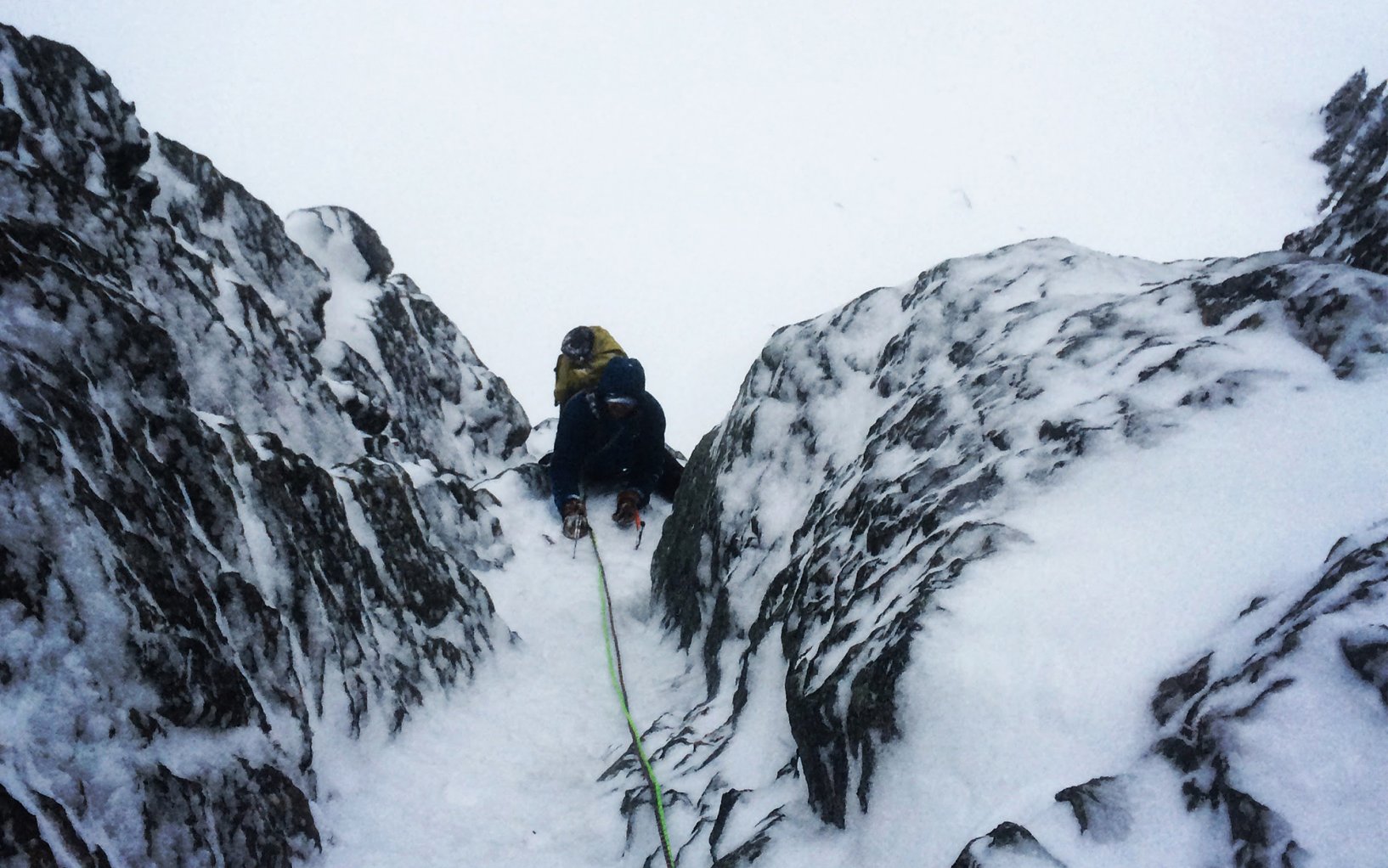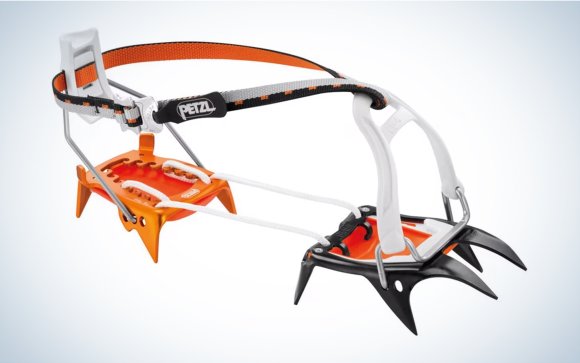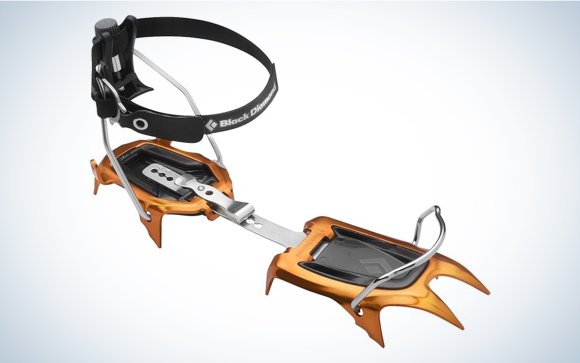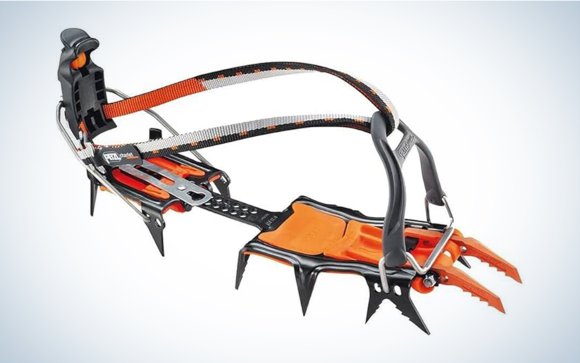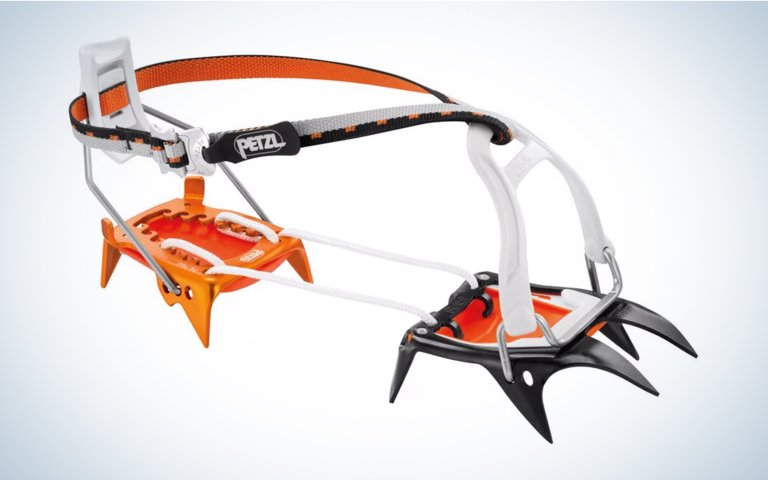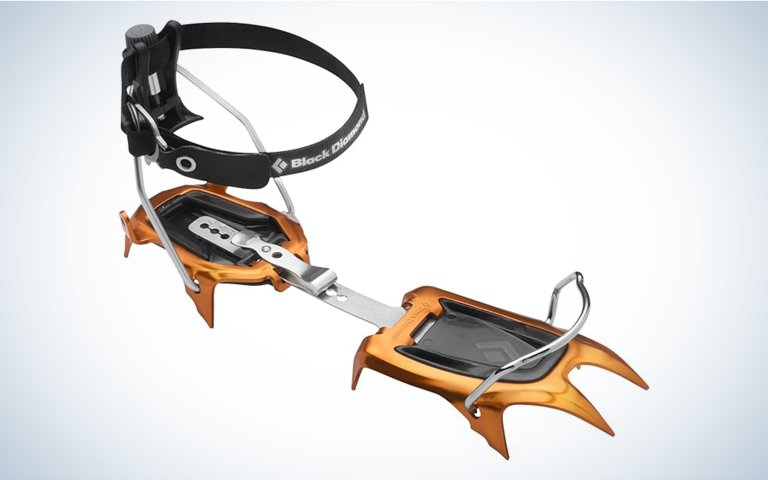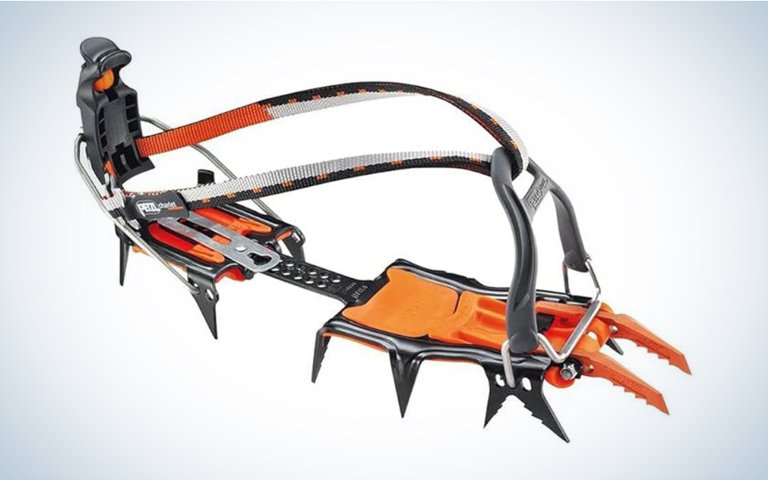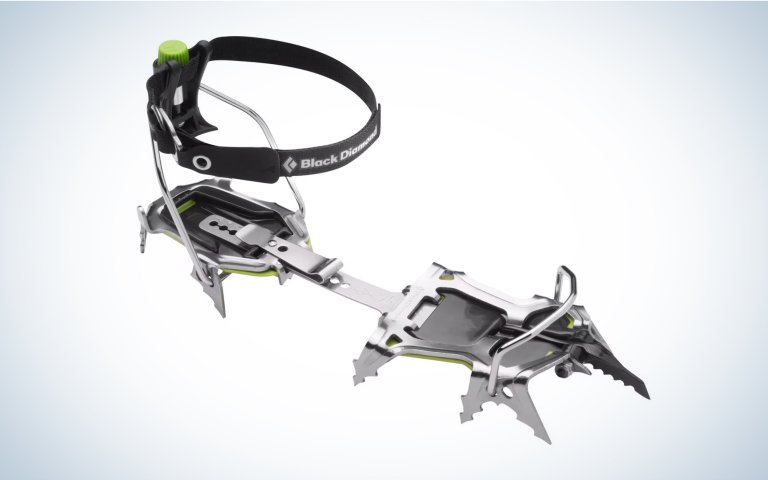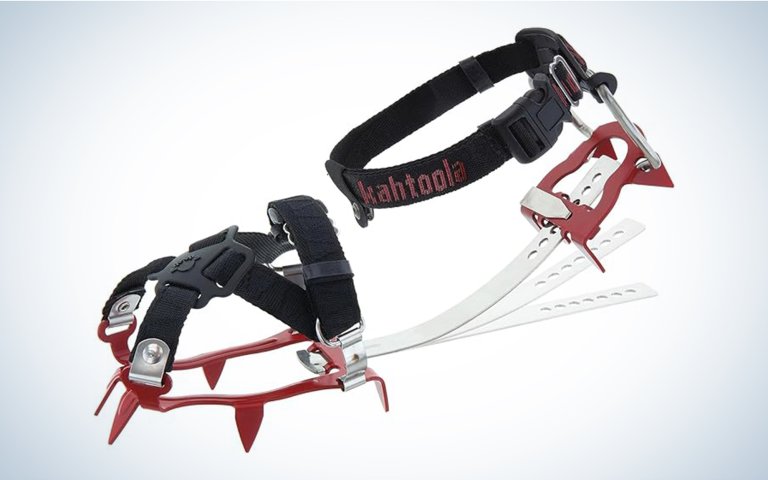We may earn revenue from the products available on this page and participate in affiliate programs. Learn More ›
Crampons are essential for traveling in the mountains where you need to move efficiently across snowfields, glaciers, and steep ice pillars. If you like to venture into this kind of consequential terrain, crampons provide much needed security by connecting you securely to the mountain. Even the earliest mountain pioneers understood the benefit of crampons; they took heavy soled boots and hammered nails through them to travel into the frozen alpine. But crampons have come a long way since those primitive days of climbing. With all the different styles and specialized uses for modern crampons out there, I tested a range of them to come up with a list of some of the best crampons for different mountain climbing styles.
- Best Overall: Petzl Irvis Hybrid
- Best Lightweight: Black Diamond Neve Pro
- Best Technical All Mountain: Petzl Lynx
- Best Steep Ice and Mixed: Black Diamond Stinger
- Best for Use Without a Mountain Boot: Kahtoola KTS Hiking Crampon
How I Tested the Best Crampons

I have been a guide and outdoor instructor in the mountains for the last 15 years. Over that time, I’ve worn an absurd amount of crampons of different styles and from a variety of manufacturers. I tested these crampons on snow, glaciers, and frozen waterfalls in the mountain ranges of the Pacific Northwest, Rocky Mountains, and Alaska. While I have pushed the limits of some of these styles, I didn’t use them for any kind of terrain that they weren’t meant for. For example, I didn’t use a hiking or lightweight crampon for technical ice climbing and vice versa.
I used many of these crampons in snow conditions that ranged from powdery winter snow to bulletproof ice. Weather during testing ran the gamut from a sunny summer day on a Washington volcano to a frigid Alaskan spring day in the single digits and everything in between. I used footwear like hiking and approach shoes as well as thick double mountaineering boots to test the fit. I focused on performance of the best crampons in the given conditions, the security of the fit, weight, and ease of adjustment (especially with gloves on).
Best Crampons: Reviews & Recommendations
Best Overall: Petzl Irvis Hybrid
Pros
- Extremely packable due to Cord-Tec linking system
- Lighter than all steel rigid crampons
- Alpen Adapt system makes the crampon fully modular
- Performs well on a variety of surfaces
Cons
- Takes extra effort to fit since the cord stretches and settles at first
- Doesn’t work as well on soft boots
Key Features
- Weight: 1.25 pounds
- Steel front piece and aluminum heel piece
- CORD-TEC linking system
- 10 points

Petzl’s Alpen Adapt system makes their crampons fully modular, meaning you can basically mix and match any piece you like to make your perfect crampon for whatever you might be doing. For the purposes of this testing, I focused on the combinations you can buy as a set from Petzl and the Irvis Hybrid performed extremely well across a wide range of activities. These crampons have become a staple in my guiding over the years and I reach for them time and time again when I know I’ll be working in changing terrain. The steel front piece provides the security you need when you’re kicking into hard glacier ice while the Cord-Tec linking system and aluminum heel piece saves weight and makes these crampons easy to stow when I have to stuff them in my pack for periods of rock climbing.

These crampons work best on a stiff boot with both heel and toe welts to make up for the soft cord connecting the toe and heel piece. But with some fussing, they’ll work fine with a soft-toed boot as well. The cord will stretch and settle at first, meaning it’s best to size them to your boot ahead of time to let them sit and then come back and tighten them up again. But this extra time spent on the fit is more than worthwhile for the performance. I’ve used this crampon on glaciers, low angle ice climbing, and short rock scrambles between snow patches and it holds up for the whole ride.
Best Lightweight: Black Diamond Neve Pro
Pros
- Very light
- Quick lock center cable makes them extremely packable
- Center cable is easily adjustable and more durable than other cord crampons
- Toe bail fits ski boots well
Cons
- All aluminum makes them less durable if moving across hard ice or rock
- Fit works better with ski boots than mountain boots
- Requires a boot with a toe bail
Key Features
- Weight: 13.9 ounces
- Aluminum front and heel pieces
- Quick lock center cable
- 10 points
The Black Diamond Neve Pro is a great lightweight option when you really need the weight savings and the technical climbing is minimal. These crampons work best with ski boots if you need traction for the steep approach, but you want to throw them in your pack and forget about them (along with all the heinous snow slogging you did) while you enjoy the ride down.

These crampons shine when the snow is softer and you don’t have to kick steps into hard ice. They do fine with the occasional rock scramble but be prepared to replace them fast as the aluminum points will dull and wear down with repeated abuse. The cable that connects them is more durable than the cord that connects other crampons in this class, meaning you can get some more mileage out of them if you use them in the right terrain because the crampon itself doesn’t fray the material. If your ski run is all you care about and you want a crampon that will make itself disappear when you’re done with it, this might be just the ticket for you.
Best Technical: All Mountain Petzl Lynx
Pros
- All steel construction makes them very durable
- Excellent fit with a variety of boots
- Front points can be easily changed to mono, dual, or offset point configuration
- Alpen Adapt system makes them fully modular
Cons
- Heavy
Key Features
- Weight: 2.25 pounds
- All steel construction
- Dual front points for vertical climbing
- 14 points
The Petzl Lynx is a workhorse crampon that excels in all kinds of terrain including the hard and vertical. These crampons are made for anything the mountain can throw at you from steep ice and mixed climbing to low angle snow walking between cruxes. The front points can be changed from dual points, to mono point, to offset points with the aid of just one allen wrench so it’s easy to dial in the technical performance. The all-steel construction allows them to stand up to repeated abuse and multiple resharpening sessions. All this makes these crampons great for all day pushes in the mountains where technical climbing is required.

The Petzl Lynx requires a boot with a heel welt and performs best when the boot also has a toe welt. They are so stiff, however, that they still work well with a soft toed boot. I’ve used them on thick double boots and lighter ice climbing boots with no complaints. They are noticeably heavier than other crampons out on the market today, but that extra weight pays off in the durability and security they provide while climbing. Sometimes, you don’t need something fancy, you just need something that works and these crampons work.
Best Steep Ice and Mixed Climbing: Black Diamond Stingers
Pros
- Very stable for a mono point crampon
- Asymmetrical design makes for intuitive climbing
- Very precise on mixed terrain
Cons
- Fit can be hard to obtain with some boots
- Not ideal for glacier walking
Key Features
- Weight: 2.1 pounds
- Mono front point
- Stainless Steel Construction
- 11 points
The Black Diamond Stinger crampon is a high-performance ice and mixed climbing piece. Usually, mono point crampons give you increased precision at the cost of stability because there are fewer points biting into the ice. But the Stinger has stainless steel points on the sides of the main front point that engage the ice to provide a surprisingly stable platform. Those same side points splay out, however, so they stay out of your way when you’re carefully placing the mono point on a rock edge or small smear of ice. This truly gives you the best of both worlds—precision when things get delicate, and security when it’s time to climb fast.

The Stinger is not a great crampon for all day glacier walking. The same features that make it excel in vertical terrain translate to serious tripping hazards when you’ve got a long day of putting one foot in front of the other on a never-ending glacier slog.
Best For Use Without a Mountain Boot: Kahtoola KTS Hiking Crampon
Pros
- Fits a soft hiking/running/approach shoe well
- Rigid crossbar provides support for soft shoes
- Easy to adjust
- Steel construction makes the crampon very durable
Cons
- Not made for terrain where there is fall potential
- Heavier than other crampons on the market
Key Features
- Weight: S/M 1.4 pounds, M/L 1.5 pounds
- Chromoly Steel Construction
- Removable Anti-balling Skins
- 10 points
Sometimes you need more security than micro spikes can provide but you aren’t going to be wearing a full-on mountain boot. Enter the Kahtoola KTS Hiking Crampon. Most long-time climbers and hikers have found themselves at some point, strapping a crampon that was designed for a mountain boot to a soft hiking or approach shoe and making do with the less-than-ideal interface between the two. The Kahtoola KTS eliminates the need for this ill-advised practice by providing security more akin to that of a traditional crampon combined with a robust binding system that tightly cradles a soft shoe.


The KTS is not the lightest crampon on the market, but remember, the weight savings come from the lighter footwear you’re able to use with it. Plus, you get to spend your day in shoes that are much more comfortable than mountain boots and your feet will thank you for that. The anti-balling skins work great to keep sticky warm snow from building under foot but are easily removed when that’s not a concern.

These crampons are best used when you’ve got a long day on your feet with small but significant sections of snow walking and you want the traction to move efficiently. These crampons are not suitable for any terrain where a fall is possible (i.e. steep snow and ice climbing or glacier travel where crevasses are present). The use of a soft shoe with this binding system means you won’t have the holding power necessary to arrest a fall or perform any kind of technical rescue.
How to Choose The Right Crampon

The fast and light ethic is almost ubiquitous in the outdoor gear world these days. But when it comes to crampons, this is not a place where you want to compromise safety just to cut grams. Picking the right tool for the job is much more important so here are a few things to consider when buying crampons:
Footwear Compatibility
Make sure the crampon you choose is well suited for the footwear you’ll be using. No one likes a sloppy fit and some shoe-crampon combinations are just not meant to be. Bring your boots in when you’re looking at crampons and play around with attaching them.
Material
The terrain you’ll encounter on your adventure is going to dictate what kind of crampon you’ll want on your feet. If you’re going to be kicking ice or pulling someone out of a crevasse, you’ll want a more robust steel crampon with a stiff boot. If you’re going to spend most of your day with crampons in your pack, only pulling them out a few times for extra security while you cross mellow snow slopes, a minimalist aluminum crampon might be the most suitable option.
Quiver vs. Quiver of 1
Crampons are expensive so knowing if you are going to commit to a shelf full of different styles or rely on one pair of old faithful can help guide your purchase(s). The more specialized the crampon, the more types you have to buy to participate in all your icy endeavors. Investing in a more general crampon on the other hand, will allow you to travel just fine in most terrain even if it doesn’t necessarily excel in any one area.
FAQs
Depending on the type and usage, crampons can last anywhere from one to five years. If you have burly steel crampons that can handle multiple resharpenings and you don’t use them much on hard ice or rock, you can probably get more life out of them. I typically buy new crampons every year with the amount of abuse I put them through in a year of guiding.
The rule of thumb is: more points means more security because you have more contact with the snow or ice surface. If you aren’t too comfortable on your feet and you anticipate walking on steep ice, you may want to opt for 12 points. But if you’re weight conscious and feel good on your feet, I find that 10 points is enough for most objectives.
I think crampons are the tool for walking on ice. When you’re trying to move over such an unforgiving medium, crampons provide essential security by keeping you attached to the mountain.
Final Thoughts
After years of using crampons to keep myself attached to mountain slopes, I’m certain that these are some pieces of your climbing kit that you want to get right. Having a crampon that properly matches up to your objective can be the difference between a fun day out in the mountains and a terrifying experience that you’re just thankful to make it back from.
- Best Overall: Petzl Irvis Hybrid
- Best Lightweight: Black Diamond Neve Pro
- Best Technical All Mountain: Petzl Lynx
- Best Steep Ice and Mixed: Black Diamond Stinger
- Best for Use Without a Mountain Boot: Kahtoola KTS Hiking Crampon
